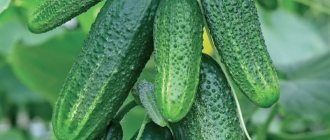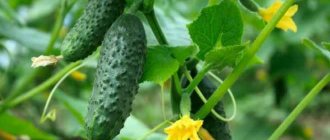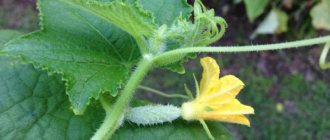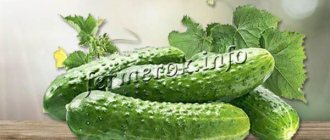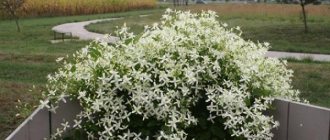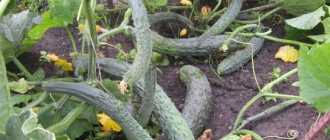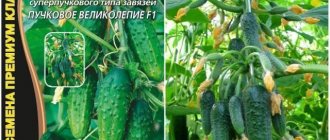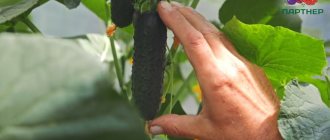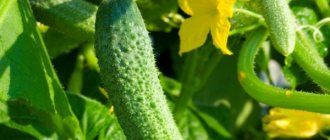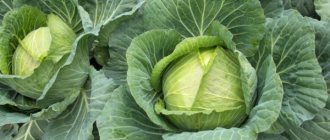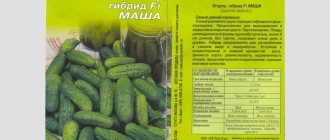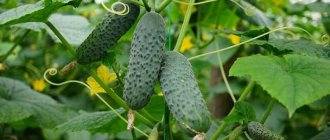Characteristics of the cucumber variety Gunnar
Gunnar F1 is a parthenocarpic hybrid of the first generation, with a female type of flowering, does not require pollination. Ovaries form in any weather. In terms of ripening period, Gunnar F1 is a mid-ripening variety. The first wave of fruiting occurs on days 38-45.
Plant of indeterminate type. The central shoot of a cucumber has unlimited growth power. That is why the Gunnar variety continues to bear fruit as long as the weather permits. The F1 cucumber hybrid can be planted twice. In the spring - for early consumption, and in the summer - to obtain an autumn harvest of greens in the greenhouse.
The central stem of the Gunnar F1 cucumber has short internodes. Judging by the description of the variety and the photo, the ovaries are formed in each bosom, 2-4 greens in one cluster. Harvesting stimulates the growth of new fruits. The F1 hybrid bears fruit in waves - 4 waves per season.
Characteristics and description
"Gunnar F1" (Gunnar) is an early-ripening gherkin cucumber, bred in 2010 by the famous international company Enza Zaden. The company's headquarters is located in the city of Enkhuizen (West Friesland region, located in the north of Holland), and the wonderful hybrids and varieties of several dozen vegetables it has created have been successfully sold all over the world for several decades.
Did you know? Enza Zaden company experts estimate that every year approximately 20 billion bushes of green lettuce planted from the seeds of this brand are grown in the world.
“Gunnar F1” appeared on the market of Eastern European countries, including Ukraine and Russia, in 2014 and immediately attracted the attention of professional farmers and ordinary summer residents. The manufacturer protects information about which cucumber varieties were used to create this hybrid, but the breeders managed to create a crop that produces a very early and high yield of delicious fruits, suitable for year-round cultivation under film or in open ground - in spring, summer and autumn.
The morphological characteristics of the hybrid are as follows:
| The power of growth | high |
| Internodes | short |
| Leaves | dark green, large, powerful |
| Type of ovary | bouquet |
| Flowering type | female (parthenocarpic) |
| Number of fruits in a bunch | 2–5 |
| Greenery color | dark green, plain, light spikes |
| Shape and structure of greens | cylindrical, rounded at the ends, the number of tubercles is average, the pubescence is strong, the skin is thin, very crispy |
| Zelentsy sizes | medium (length - 12-15 cm, thickness - up to 3.5 cm, weight - up to 120 g) |
| Harvest marketability percentage | 100% |
"Gunnar F1" is a parthenocarpic plant. This means that the cucumber produces exclusively female flowers that do not require pollination. The term "parthenocarpy" literally translates as "virgin fruit" (from the Greek "parthenos" - virgin, and "karpos" - fruit).
Important! In self-pollinating cucumbers, the flowers have both a pistil and a stamen, that is, they are, as it were, bisexual. They need pollination, it just happens faster than in varieties with heterosexual flowers, while in parthenocarpic plants fertilization occurs without pollination.
When describing the technical characteristics of the Gunnar F1, it is worth noting the following important indicators:
| Classification by ripening time | ultra-early |
| Possible number of harvests per season | up to four |
| Taste characteristics of greens | sweet, juicy, with a bright honey aroma |
| Tasting rating on a 5-point scale | 4,9 |
| Resistance to adverse weather conditions | shade-tolerant, drought-resistant, can grow in saline soil |
| Resistance to cladosporiosis and powdery mildew | high |
| Resistance to cucumber mosaic, downy mildew, yellowing | average |
Comparing “Gunnar F1” with other popular hybrids, including the Enza Zaden selection, it should be noted that, according to most experts, it is superior to:
- “Herman F1” - according to seed germination and bush growth vigor;
- “Tatyana F1” - in terms of marketable qualities and yield (by more than 30%);
- “Gambit F1” - in terms of yield (almost 25% when grown in unheated greenhouses);
- "Björn F1" - according to the size and weight of the fruit.
Taste qualities of cucumbers of the Gunnar F1 variety
Summer residents who grow the Gunnar F1 hybrid in their greenhouses are unanimous in their assessment of the taste of greens. Everyone finds it excellent. The tender, juicy pulp of cucumbers has no bitterness, it is always aromatic. Gunnar F1 greens do not overripe. This is a big plus for summer residents who rarely visit the countryside. Ripe fruits can hang on bushes in a greenhouse for 1-2 days without losing their taste and marketability.
Important! Gunnar F1 greens have a dual purpose - canning and salad.
The main characteristics of the fruits of the Gunnar F1 cucumber are shown in the table.
| Zelentsy parameter | Description |
| Form | Cylindrical |
| Weight | 90-110 g |
| Length | 8-12 cm |
| Color | Uniform, dark green, no stripes |
| Skin | lumpy |
| Taste rating | 5 points |
Zelentsy can withstand long-term transportation without any problems. Cucumbers are stored well and for a long time for 1.5-2 weeks.
Landing rules
Cucumbers of the hybrid form "Gunnar" are very susceptible to compliance with the rules of sowing and growing seedlings:
We also recommend reading: Zyatek cucumbers Description of cucumbers Director f1 Cucumbers Uranus Cucumbers in a barrel
- after sowing and until the first shoots, the temperature should be maintained at 26-27°C;
- the emergence of seedlings requires a gradual decrease in temperature to 20°C during the day and 19°C at night;
- 24 hours before transplanting seedlings to a permanent place, the temperature should be reduced by a couple of degrees;
- The soil should be warmed to 21°C at the time of planting seedlings.
Cucumbers “Emerald City”: features of the variety
Seeds should be sown on ridges when the top layer of soil warms up to 16°C with a seeding depth of 1.5-2.0 cm. When cultivating in unheated greenhouse structures, seeds are sown in early May, and seedlings with 3- 4 true leaves, planted in mid-May.
Pros and cons of the variety
Reviews of the Gunnar F1 cucumber are positive. Among the disadvantages of the F1 hybrid are the high cost of seeds, weak immunity to powdery mildew pathogens, and the presence of voids in the pulp of greens due to irregular watering.
The list of advantages of the variety is impressive:
- stable yield, little dependent on weather;
- work on forming a bush does not take much time;
- stable immunity of cucumber to brown spot (cladosporiosis);
- beautiful shape and color of greens;
- excellent taste of cucumbers;
- universal purpose of fruits;
- keeping quality (1.5-2 weeks);
- transportability of greens.
Advantages and disadvantages
The advantages of plants of this hybrid are as follows:
- good seed germination;
- they begin to bear fruit early;
- they do not require pollination;
- the hybrid is characterized by high yield;
- cucumbers grow evenly, uniformly and do not overgrow;
- all collected products differ in presentation;
- excellent transportability and keeping quality of greens.
No disadvantages were found in the Gunnar hybrid, except for the relatively high price of the seeds and the fact that they will need to be purchased every year, since those collected from their own plants do not pass on hereditary qualities to their offspring.
Optimal growing conditions
For growing Gunnar F1 cucumber, greenhouses with a polycarbonate, glass, or film coating with a height of at least 2 m are suitable. The variety shows maximum yield in protected ground. In the southern regions, where cucumber is cultivated in open ground, the productivity of the variety is 1.5 times lower.
For vigorous shoots, it is recommended to build a trellis. To create an ideal microclimate for the variety, a ventilation system is provided. It will be equipped with automation. Use drip irrigation. With its help, the necessary soil and air humidity is maintained, and root feeding of Gunnar F1 cucumbers is carried out.
Harvesting and consumption
Greens can be harvested approximately 1-1.5 months after germination. The peculiarity of the variety is that when overripe, cucumbers do not become barrel-shaped, so overexposure on the plant is not harmful to them. The taste does not deteriorate for up to a week, although, of course, young fruits have a more delicate taste.
The hybrid is suitable for fresh consumption, salads, snacks. However, Gunnar F1 is also suitable for processing and canning. In jars and marinade, cucumbers do not lose their taste, “absorb” the piquant notes from the marinade, and become crispier.
You can make a good business by growing Gunnar F1 cucumbers; they are profitable for sale and mass distribution to production. Due to its excellent commercial qualities, the demand for greens of this type is consistently high.
Technology of growing cucumbers Gunnar
It is convenient to grow cucumbers of this variety. The plant is compact, the side shoots are short. This makes it easier to care for the plantings and simplifies the collection of Gunnar F1 greens.
Direct planting in open ground
Gunnar F1 seeds are sown in open ground in late May - early June. The earth should warm up to 17 °C. For active fruiting, the soil structure is improved by adding mineral fertilizers (ammophoska 25 g/m2), humus and peat. If the acidity is high, deoxidize with dolomite flour.
The holes are placed at a distance of 20 cm from each other and watered. Sow 2 seeds in each. Sprinkle with a layer of humus, do not water it. Before the cucumbers emerge, the holes are covered with film or plastic bottles. Row spacing in open ground is made wide - 1.4 m.
Growing by seedlings
To prevent diseases, Gunnar F1 seeds are treated with the fungicide “Fitosporin-M” before sowing. Sow them in separate containers so as not to dive. Cucumbers need soil that is loose, fertile, well-permeable, and retains moisture.
| Greenhouse type | Timing of sowing seeds for early harvest | Timing of sowing seeds for harvest in autumn |
| Heated | From February to March | Early August |
| Not heated | Last days of April | July |
Drainage holes (1-2 pcs.) are made in the lower part of the container, and drainage is poured onto the bottom. Use broken eggshells. The soil is watered with a Fitosporin solution 5 days before planting cucumbers. It destroys pathogenic microflora.
Before emergence, the containers are covered with film, creating greenhouse conditions. The temperature is maintained at 25-27 °C. Cucumber sprouts hatch in 5-7 days. From the moment the seedlings emerge until the seedlings are transplanted to a permanent location, the temperature in the room during the day is maintained at no higher than 20 °C, and at night it is reduced to 18 °C.
Important! At the age of 25-30 days, seedlings of Gunnar F1 cucumbers can be planted in a permanent place. The seedlings should have 4-5 leaves.
Caring for Gunnar F1 seedlings is standard, it includes:
- organization of artificial lighting;
- watering with water at room temperature;
- root feeding with urea (1 tsp per 3 liters of water) in the 4-leaf phase;
- root feeding with a solution of nitroammophoska (1 tsp per 3 liters of water) with the addition of ash (1 tbsp).
Cucumber seedlings are transplanted into a greenhouse when the soil in it warms up to 20 °C. The ridge is prepared in advance. Add humus, vermicompost, peat, and ash. Fertilizers include urea, superphosphate, and potassium nitrate. Cucumber seedlings are planted according to a 35 x 50 cm pattern.
Watering and fertilizing
Cucumbers are watered at the root with warm, settled water. They do this early in the morning (before 10-00) or in the evening from 17-00 to 20-00. During the day, especially in sunny weather, watering is not recommended. Drops of water on the leaves cause burns, which weakens the plant's immunity.
The frequency of watering depends on the weather. When it gets colder, their number decreases. Ideally, the top layer of soil should always be moist. In hot weather, cucumbers in a greenhouse can be watered every other day. Drip irrigation is the best option for Gunnar F1 cucumbers.
To obtain the declared yield (23 kg/m²), cucumbers need to be fertilized throughout the season. The first feeding should be carried out 14 days after transplantation. Use slurry (1 liter per 9 liters of water) or urea solution (1 tablespoon per bucket).
Before flowering, root fertilize the cucumbers:
- water – 10 l;
- urea – 20 g;
- potassium salt – 20 g;
- superphosphate – 40 g.
When the ovaries appear on the bushes, water the Gunnar F1 cucumbers with a solution of nitroammophoska. Dissolve 1 tbsp in a bucket of water. l. fertilizers After 2 weeks, feed the plants with potassium fertilizer.
Advice! To fertilize the Gunnar F1 cucumber, you can use fertilizers “Gumat”, “Radifarm”, “Magnisal”. Their effectiveness has been tested in practice.
Formation
The side shoots of Gunnar F1 are short; they do not need to be removed, but in this case you should not count on an early harvest. It is recommended to blind the 5 lower sinuses. Remove the stepsons and ovaries that have formed in them. This procedure directs the plant’s forces to the growth of the central shoot and the formation of new ovaries.
After the 5th leaf, you can manage the bush in two ways:
- in each bosom, pluck out the stepsons, leaving the ovaries;
- Do not remove the stepchildren, pinch their growth point after the formation of 3-5 leaves.
Important! A bush formed into one stem produces a harvest earlier. The development of stepchildren requires more nutrients, moisture and light.
The central shoot quickly reaches the top of the trellis. It needs to be thrown over the top wire and directed downwards. Remove the growing point when summer wanes and night temperatures in the greenhouse drop.
Growing and care
The hybrid is actively grown in various conditions - greenhouses and greenhouses (with and without heating).
Standard care and agricultural practices:
- Frequent regular watering. Drip irrigation brings good results. The water must be heated. With normal moisture, water once every 2-3 days.
- Mulching. Lay out a layer of 6-7 cm from materials (straw, compost, peat, straw).
- Loosening and weeding to prevent the formation of crusts.
- Feeding. Multiplicity at least 4-5 times during the cultivation period. Organic matter is used in the form of mullein and manure solutions. Mineral compounds are added - potassium salts, superphosphate, mixed mixtures.
- Garter. The shoots are fixed to trellis structures and high posts.
- Collection. The greens are picked regularly - after 1 or 2 days. Optimal sizes are within 10-14 cm.
Formation
The bushes lead into 1 stem. The lower 5-6 sinuses (ovaries and shoots) are removed. In the future, the formation is carried out as follows: the side branches are pinched, the ovaries are left. Remove sick, aged, yellowed leaves from below. There should be 5-7 cucumbers left on 1 lash to avoid overloading the bushes.
Diseases and pests
With good care, cucumbers in a greenhouse practically do not get sick. The cause of the disease can be a sharp cold snap or prolonged heat. To catch the infection at the initial stage, the bushes need to be regularly inspected and measures taken when the first alarming symptoms appear.
Shoots and fruits may die from powdery mildew. As a result, the yield in the greenhouse drops by 60%. For preventive purposes, plantings are sprayed with Fitosporin-M solution and folk remedies are used. Aqueous solutions are prepared for spraying:
- iodine;
- whey;
- brilliant green.
To prevent fungal growth, the greenhouse maintains a humidity level of no higher than 80% and an air temperature of about 24 °C. The soil is covered with organic mulch (straw, peat, sawdust) or black covering material.
Gunnar F1 cucumber plantings may be damaged by insects. Plants in a greenhouse can be attacked by:
- aphid;
- sprout fly;
- spider mite
You can get rid of them in a greenhouse using Karbofos or tobacco infusion with the addition of an adhesive (liquid soap).
What to feed?
For best growth, cucumbers must be treated with complex fertilizers at various stages of cultivation. Offer plants nitrogenous fertilizers. As an option: dilute 60 grams of superphosphate and 20 grams of urea in ten liters of water. Or use the following recipe: take 10 grams of ammonium nitrate, superphosphate, potassium salt and pour into a bucket with ten liters of water. As an addition to mineral fertilizers for cucumbers, rotted compost based on cow manure or chicken manure can serve.
The cucumbers are then fed just before flowering. Makes the following mixture: take and mix 20 grams of potassium and ammonium nitrate, 40 grams of superphosphate per 10 liters of water.
It is recommended to sprinkle the soil with ash obtained from burning logs after watering and before loosening. If you don’t want to get fancy with your own prepared cucumber fertilizers, then you can use ready-made mineral fertilizers purchased in the hardware department of the store. For example, such as:
- "Radifarm".
- "Magnisal".
- "Gumat".
Productivity of cucumber variety Gunnar F1
The yield of Gunnar F1 cucumbers planted in spring is higher than with summer sowing. During the spring-summer season, 17-23 kg/m² of greens are harvested in greenhouses, and 8-13 kg/m² during the summer-autumn period. All fruits are of good quality. Farmers have a 100% yield of marketable products in greenhouses. The variety responds well to fertilizing.
Zelentsy are collected regularly. If this is not done, new fruits will form more slowly. They are collected in the morning or late in the evening. At this time, greens contain more moisture. It is better to cut them with garden shears so as not to damage the lashes.
The greens harvest is used for fresh consumption and used for harvesting. Gunnar F1 cucumbers can be stored in a cool cellar for up to 2 weeks. They are placed in vegetable boxes.
Gardeners' opinions
“It grows very conveniently for growing in a greenhouse - in one stem.
Easy to care for. On the top tier I placed a rail with rounded shapes. No tying required. He carefully pulled up the plants, threw over the fruits and vines. All the greens are visible, they don’t hide behind leaves, they don’t lie on the ground.” Anatoly, 42 years old. “I received a very large harvest, which was not even expected. In addition, the cucumbers had been bearing fruit for so long that there were no leaves left on the vines, and the greens were still ripening. The stems are strong and have not deteriorated throughout the summer.” Valentin, 38 years old.
“This variety of cucumbers requires constant watering. I watered it morning and evening. The rest is simple. The taste captivated me: they crunch and emit a special aroma. Easily served with pickling: a day in brine, and the dish is on the table. I recommend it to everyone.” Zinaida, 34 years old.
WISH YOU A RICH HARVEST!!!
Your LYUBASHA BODIA
Reviews of Gunnar cucumbers
Elena Viktorovna, 48 years old, Volgograd
I grow it indoors. The seeds are not cheap, 1 pack costs more than 30 rubles. They grow and set well. There are no problems with pollination. We collect the first harvest in 1.5 months. They sing together. The greens of the hybrid are cylindrical, dark green, up to 9 cm long. When planting, I add ash and humus to the ground. In the summer I monitor the temperature in the greenhouse, trying to maintain it no higher than 25 °C so that the ovary does not fall off. We eat Gunnar F1 cucumbers only fresh; I don’t use them for preparations. The pulp of greens is tasty and aromatic.
Andrey Petrovich, 67 years old, Krasnodar region
I have a greenhouse. I love experimenting with new varieties of cucumbers. This summer I grew Gunnar F1. Planted with seeds, germination rate 100%. The lashes are powerful and well leafy. 4-6 ovaries were formed in each internode. The peak of fruiting occurred on the 70th day. Gunnar F1 has dark green fruits. The pimples on the greens are medium sized. There were few overgrown cucumbers (barrels). There was no powdery mildew on Gunnar.
Landing rules
Cucumbers of the hybrid form "Gunnar" are very susceptible to compliance with the rules of sowing and growing seedlings:
- after sowing and until the first shoots, the temperature should be maintained at 26-27°C;
- the emergence of seedlings requires a gradual decrease in temperature to 20°C during the day and 19°C at night;
- 24 hours before transplanting seedlings to a permanent place, the temperature should be reduced by a couple of degrees;
- The soil should be warmed to 21°C at the time of planting seedlings.
Seeds should be sown on ridges when the top layer of soil warms up to 16°C with a seeding depth of 1.5-2.0 cm. When cultivating in unheated greenhouse structures, seeds are sown in early May, and seedlings with 3- 4 true leaves, planted in mid-May.
Agricultural technology or proper cultivation
Following the basic rules will allow you to get a good, abundant harvest:
- To speed up the germination process of seed material, the temperature should be maintained within 26 degrees;
- After the first shoots appear, the temperature is lowered to 20 degrees during the day and to 16 degrees at night;
- As soon as two pairs of full-fledged leaves are formed, they begin planting in a permanent place;
The most favorable period is mid-May.
- The day before transplanting into a greenhouse structure, the temperature in it should be lowered by about 2 degrees;
- The soil temperature should be about 21 degrees.
It is advisable to grow cucumber crops in sunny, windless areas. The optimal direction of the ridges is from north to south. Plants are planted at intervals of 40-50 cm.
Ripening time
This variety is a very early one, so harvesting can begin 30-40 days after planting. It is important to note that when outgrown, the greens do not acquire a “barrel-shaped” shape and always have an even streamline.
It has good regeneration, which allows you to get 4 “waves” of harvest from the main stem. "Gunnar F1" has good shade tolerance and is suitable for the earliest planting dates.
